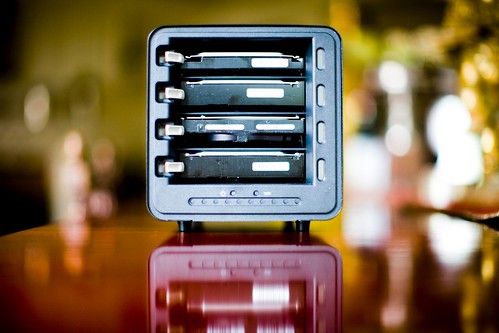Photo Backup: RAID Tower

photo credit: Thomas Hawk
In the previous section of this “photo backup” series, we went over the external hard drive. This article deals with something that's a bit fuzzy to define — the RAID tower. It's similar to an external drive, but it can also be used as a working drive and/or a backup drive.
FOLLOW THIS SERIES OF ARTICLES!
TOC — PHOTO BACKUP GUIDE
BACK — HAVE YOU EVER NEEDED TO USE YOUR PHOTO BACKUP?
NEXT — DVD
So again, I'll try to lay out the topics in a similar fashion to the previous articles. And hopefully the technology doesn't change on us before you read this.
THE BASICS
A RAID tower is a collection of two or more internal hard drives housed in a box that contains special RAID (Redundant Array of Inexpensive/Independent Disks) hardware/software, and connects to your computer as if it were a single external hard drive. These towers can be utilized as a working drive or a backup drive, depending on your needs. In either case, the tower is designed to protect your data from hard drive failures (typically one disk can fail and you'll still be able to recover your data).
RAID towers come in various shapes and sizes, but the most common form is a cube-like enclosure that holds 4 hard drives. The towers that hold 4 drives are capable of a RAID 5 configuration. Other towers may only hold 2 drives, and these are capable of a RAID 1 configuration. In either case, your data is protected against the failure of a single drive. The difference is that RAID 5 allows you to use more of your disk space (RAID 1 is just a mirror, so one whole drive is used for backup).
RAID towers have similar data connections to external hard drives (so I won't go over them again), but some towers will have multiple connections to boost the data transfer rates. Some will also have the ability to be networked via Ethernet.
One deviant of the typical RAID tower is the Drobo. Typical RAID setups require that all drives be the same capacity (or it considers all drives to be the same capacity as the smallest drive). The Drobo is a bit different in that it can utilize drives of various capacity, and you can upgrade your hardware as your photo collection grows.
BACKING UP
The nice thing about these towers is that they are intended to take care of the real-time backup for you. If you're using it as a working drive, the RAID configuration will automatically backup your work as you go. If one of your hard drives in the tower decides to fail, you can simply replace the drive and the tower will rebuild your missing data.
If you decide to use the tower in a similar fashion to an external hard drive backup, you'll still need to find some software that duplicates your work from your working drive to the backup drive. But again, if one of the drives in the tower gives up, you can replace it easily without having to re-backup your entire working drive.
In either case, the stuff contained in the box has a layer of redundancy. But it's certainly not a solve-all solution. No single backup method can protect against every possible failure.
STRENGTHS
RAID towers are easy and expandable. The embedded hardware and software takes care of backing up your data, so you don't need to be as diligent about manually backing up photos. The other main perk of these towers is that you can upgrade the storage capacity as your collection grows. Standard RAID 5 towers will require that all drives be of the same capacity, but a unit like the Drobo overcomes this limitation.
RAID towers are also somewhat portable and they can be accessible via a network. If you had to take one with you somewhere for some reason, you could do it. And hooking it up to your local network is a great way to ensure access to your photos from several computers around your home or office.
WEAKNESSES
RAID towers are still basically an external drive, with a limited connection speed. Most users will never notice this limitation, but it is a limitation nonetheless. The other downside to a tower is that you're only protecting against hard drive failures if you use it as a working drive. Fire, theft, and other major disasters can wipe out all your drives at once. And like external drives, you've got a box of hardware sitting on some desk or shelf just waiting to be knocked over.
CONCLUSIONS
If you can justify the cost of a RAID tower, they're certainly worth it. These devices add an extra layer of protection against common failure modes. I would, however, strongly suggest that if you decide to use a tower as your main working drive, to also use a secondary method of backup. Putting all your eggs in one basket is never a good idea.
I would suggest a RAID tower for folks with a considerable sized photo collection, maybe 500GB or more. Anything less than that, and you might as well just use a single drive for working and another single drive for backup. But as your collection grows into the terabytes, you'll need more than a single drive to work with.
PRODUCTS
Note: Feed readers will have to visit the website to view selected products.




Mark Groves
November 5, 2008Great series Brian. I did a post on how I use a Windows Home Server machine for my photography backup. https://markgroves.us/2008/10/05/photo-backup-my-process/ This may be overkill of some users, but I get other features out of the Home Server that I find beneficial.
Thomas Hawk
November 5, 2008Great article Brian. I love my drobos. Replicated primary storage is a beautiful thing!
Brian Auer
November 5, 2008@Mark Cool setup! When it comes to seriously protecting your data, I don’t think there are too many things out there that would be considered overkill.
@Thomas Yeah, it seems like everybody who has a Drobo is more than happy with it. I don’t think I’ve heard any major complaints from users, other than the initial cost of the hardware. But hey, if you can drop $500 on a lens, you can just as easily drop $500 on a Drobo.
Greg
November 10, 2008Great writeup Brian! This isn’t an easy topic to distill down to simple terms, you did a great job in that respect.
I have been running a RAID system for over 2 years now. I heard about the Drobo about 9-12 months before it was released but couldn’t wait for it, so I went with a ReadyNAS RAID system. I have a number of write ups about my experiences with it on my personal photo blog, only one small annoyance to date!
One RAID issue you didn’t mention is that fact that you have to be careful about shutting down the RAID cleanly. Just “flipping the switch” or losing power on the box will result in the RAID doing a bootup check when you turn it back on. Depending on the size of your array, this could take an hour or more, and each RAID system does it differently–some you can work on while this is done, others you can’t. I lost power a number of times due to our California brown outs and eventually bought a small UPS and now have my RAID plugged into it. Just one more fact about life with a RAID.
On the same topic of this post, I have a poll running on the FocalPower blog asking what type of device photographers use to store their local photo archive. We are considering some interesting features for our launch and want to know what photographers are using.
Brian Auer
November 10, 2008Wow, great comments Greg! That’s a real pain-in-the-butt about the bootup check. But hey, battery backups are a good thing to have anyway.
Howard
November 12, 2008Just a question. As I understand Drobo, there can be four drives in the box, and yet you only get ONE backup. Sure, the backup is duplicated on the four drives for safety, but still, only one backup. Is that right? Seems to me that using a box with four drives as a JABD (just a bunch of drives) setup would be cheaper. You can manually duplicate your work on, say two of them, and then you have two other drives for something else. Seems a better use of one’s money. But, I haven’t used a Drobo, so I might not understand what is happening. Any help?
Brian Auer
November 12, 2008Four drives, but they act like one. As you put more drives in the box or upgrade your existing drives, your overall capacity goes up. In addition, the data is protected from failure of any one drive because of the redundancy in the RAID setup.
Like I said, these are good for people with very large storage needs. I believe you can get 16TB out of one Drobo, and they have another piece of hardware that allows you to connect two of them together — so you could potentially end up with a 32TB drive.
rob jaudon
November 23, 2008Great article. I have been thinking about getting a Drobo for a long time but I think they are a little but expensive and to enable it to connect to the network you have to buy the optional network share thingy for another 2 bills. That sucks. However, I do like the idea of 4 drives and the backup solution. I just had a 1st gen Ximeta drive tank on me and I am in the process of doing a RAW copy as we speak. My only issue with any of these solutions are whenever you install a connected device I have not seen a way to detect if the hard drives within are going bad. The Ximeta Drive did not warn me and I also have a Netgear two drive NAS device that really sucks from the standpoint of disk management. I would like a way to be alerted if the HD are failing in my backup device! This has prevented me from getting any of the solutions thus far. I also have been looking at the Windows Home server for this. I would think that would solve my issue of disk checking and possibly getting a warning before it is to late. I am going to read Mark’s blog about his Windows home server write-up and go from there.
I would love to hear some thoughts on getting something setup that would alert me if my backup solution is starting to fail.
P.S. Brian….Your site rocks.
thomas fallen
February 8, 2009you kind of touch on it, but I think it can’t be over stated. RAID isn’t a substitute for backups. If you accidentally delete a file off the RAID (or over write it, or whatever) the RAID will dutifully mirror the delete so it’s gone for good.
Ivey Goodman
December 2, 2009thank you so much for the info. i’m doing a presentation on security measures and how they can be used in the business, since i have my own photography business, this was a great topic to discuss, especially since i will be implementing this into my business in the near future….
thank you again!
-The Fourth